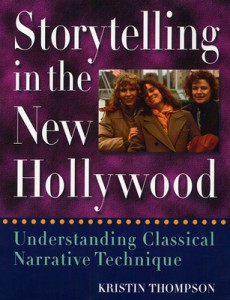Storytelling in the New Hollywood
Understanding Classical Narrative Technique


Moyenne des votes : ![]()
| 0 | vote | |
| 0 | vote | |
| 0 | vote | |
| 0 | vote |
Votre vote : -
Description de l'ouvrage:
In a book as entertaining as it is enlightening, Kristin Thompson offers the first in-depth analysis of Hollywood's storytelling techniques and how they are used to make complex, easily comprehensible, entertaining films. She also takes on the myth that modern Hollywood films are based on a narrative system radically different from the one in use during the Golden Age of the studio system.
Drawing on a wide range of films from the 1920s to the 1990s--from Keaton's Our Hospitality to Casablanca to Terminator 2--Thompson explains such staples of narrative as the goal-oriented protagonist, the double plot-line, and dialogue hooks. She domonstrates that the "three-act structure," a concept widely used by practitioners and media commentators, fails to explain how Hollywood stories are put together.
Thompson then demonstrates in detail how classical narrative techniques work in ten box-office and critical successes made since the New Hollywood began in the 1970s: Tootsie, Back to the Future, The Silence of the Lambs, Groundhog Day, Desperately Seeking Susan, Amadeus, The Hunt for Red October, Parenthood, Alien, and Hannah and Her Sisters. In passing, she suggests reasons for the apparent slump in quality in Hollywood films of the 1990s. The results will be of interest to movie fans, scholars, and film practitioners alike.
Revue de Presse:
“Thompson...trespasses on the turf of the screenwriting gurus here, gun in hand, to blast away at the three-act structure universally accepted in the business since Syd Field codified it in his 1979 book Screenplay. In its place she proposes four acts, sections of roughly equal length which she labels 'setup,' 'complicating action,''development' and 'climax and epilogue.'”―Alistair Owen, The Independent
“It was wonderful to read a book where I felt the writer knew what was going on in my mind while I was directing the film. Kristin Thompson was able to illuminate all the structural twists and turns of the plot, the character development, as well as the small details and symbolic references that directors put into their work, but often go unnoticed by the average moviegoer.”―Susan Seidelman, Director Desperately Seeking Susan
“Thompson's insightful analysis of Ground Day and of the screenwriting process in general should be fascinating toboth writers and audience alike. More thoughtful writing and more discerning audiences can't help but lead to better movies, and this informative and provocative book is a step in that direction.”―Harold Ramis, Director, Ground Day
“How refreshing to encounter a film scholar who understands that, first and foremost, movies must be written. Thompson's book offers an invaluable resource not only to professionals, but to any dedicated moviegoer who wants to better understand the intricate cratf of telling stories on film.”―Ted Tally, Screenwriter, The Silence of the Lambs
ThompsonAcoauthor of The Classical Hollywood CinemaAdoesn't agree with current film historians who claim that a "post-classical" style (fragmentary scenes often built around spectacular stunts, stars, and special effects) now dominates American moviemaking. The classical narrative style, a unified narrative of an easily understood chain of cause and effect with a goal-oriented protagonist that was popularized in Hollywood's Golden Age, remains the norm. To prove her point, she analyzes the narrative structure of ten popular films of the 1980sAincluding Amadeus, Alien, Tootsie, and Parenthood. This analysis of individual films forms the bulk of the book. Thompson also takes the opportunity to critique another popular notionAthe three-act pattern predominant in Hollywood screenwriting manuals. She prefers a film structure divided into four parts of roughly equal screen time: the setup, the complicating action, the development, and the climax. Well argued and well presented, this book is recommended for academic and special subject collections.AMarianne Cawley, Charleston Cty. Lib., SC
Copyright 1999 Reed Business Information, Inc. From the Library Journal
Voir le site internet de l'éditeur Harvard University Press
> Du même auteur :
Film History (2021)
An Introduction
de Kristin Thompson, David Bordwell et Jeff Smith
Sujet : History of Cinema
The Classical Hollywood Cinema (2015)
Film Style and Mode of Production to 1960
Minding Movies (2011)
Observations on the Art, Craft, and Business of Filmmaking
de David Bordwell et Kristin Thompson
Sujet : General
The Frodo Franchise (2007)
The Lord of the Rings and Modern Hollywood
Sujet : One Film > The Lord of the Rings
> Sur un thème proche :
A Guide to Post-classical Narration (2023)
The Future of Film Storytelling
Sujet : Technique > Scriptwriting
Introduction to Screen Narrative (2023)
Dir. Paul Taberham et Catalina Iricinschi
Sujet : Technique > Scriptwriting
The Art of Cinematic Storytelling (2020)
A Visual Guide to Planning Shots, Cuts, and Transitions
Sujet : Technique > Scriptwriting
Impossible Puzzle Films (2016)
A Cognitive Approach to Contemporary Complex Cinema
de Miklós Kiss et Steven Willemsen
Sujet : Technique > Scriptwriting
Beyond the Monoplot (2025)
How to Write Unconventional Films (and Why We Should)
de Chris Neilan
Sujet : Technique > Scriptwriting
Rem Koolhaas as Scriptwriter (2025)
OMA Architecture Script for West Berlin
Sujet : Technique > Scriptwriting